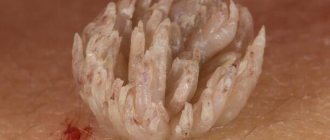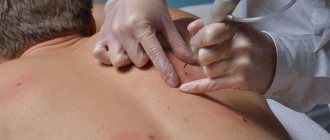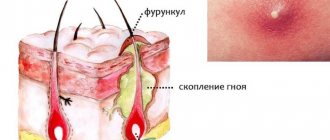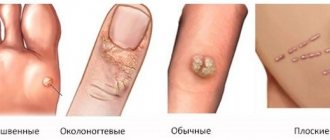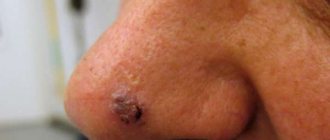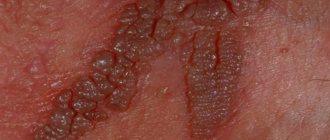The occurrence of papillomas, condylomas and warts depends on the presence of HPV in the body. Over the past 10 years, the number of infected people has increased by 10%, and if not so long ago 80% of people suffered from HPV, now 90% of the world population are carriers of the virus.
Parasitizing at the cellular level, HPV waits for a sharp decline in immunity and then begins to form cells that lead to the appearance of tumors. About 150 strains of the disease have been studied, many of them cause the development of malignant tumors.
Most often, papillomas and condylomas do not pose an oncogenic risk. We suggest you familiarize yourself with the general characteristics of growths - this will help to identify and prevent all kinds of health threats.
Papillomas
They look like a small formation, not exceeding 1 cm in size, attached to the body or mucous membrane with the help of a thin stalk, at the end of which a round lump is formed, which makes the papilloma look like a pacifier. It can be white, pink, yellow, brown, and rarely takes on the color of the skin.
The appearance of the growth is caused by 1, 2, 3, 4, 10 strains of papillomavirus, which are safe.
People treat such growths as a cosmetic defect, which is located:
- in the armpits;
- on the face and neck;
- on or under the breasts;
- on the oral mucosa;
- on the genitals.
Condylomas acuminata
They stick out from the skin, resembling a thread. They can reach a height of up to 1 mm. The colors are pink, red, white, brown. Extremely contagious, capable of multiplying in a short time. There are 3 types of genital warts:
- intraepithelial - grows deep into the skin;
- pointed - the most common type;
- flat - grows in the cervix.
If left untreated, condylomas develop into a cancerous tumor. Caused by 16, 18, and other cancer-dangerous strains of papillomavirus. They are located on the genitals and mucous membranes, and can easily appear in the cervix and lead to problems with the birth of the baby.
Comparative characteristics of the nature of formations
Condylomas in 92% of known cases are sexually transmitted and it is extremely rare to meet someone who became infected through household items of the carrier of the infection. With papillomas the situation is the opposite.
When immune protection is restored, papillomas may disappear on their own. There is only one remedy for condylomas - effective treatment. They are not able to remove themselves from the surface of mucous membranes or skin.
Causes of infection
What is the difference between condylomas and papillomas (photo)
on the skin? Condylomas are a genital type of infection; therefore, they are most often transmitted during sexual intercourse with an infected partner. This can happen as a result of anal, oral or vaginal intercourse. The possibility of infection through kisses cannot be ruled out. Much less often, this type of virus can be picked up at home. A child can become infected from an infected mother when passing through the birth canal.
Papillomas, like condylomas, can also be transmitted from an infected partner during intimate intercourse. You can become infected with them at home, through dishes, towels, and personal belongings of the infected person. Children can catch the infection in public places - kindergartens or schools.
Once in the human body, the virus does not appear immediately, but only against the background of:
- reducing the body's defenses;
- hormonal imbalance;
- vitamin deficiency;
- frequent stress;
- presence of bad habits;
- exacerbated chronic diseases;
- addition of infection;
- lack of sufficient hygiene;
- taking certain medications;
- long-term treatment with antibiotics or hormonal drugs.
Herpes in the body can also provoke frequent HPV activity. Treatment of infectious formations is selected in a comprehensive manner, aimed at eliminating the provoking cause, removing growths and strengthening the body.
How to distinguish papillomas from condylomas?
- Pay attention to the appearance - papillomas are attached to the skin with a thin stalk, 1 mm high, on which a plaque is formed, and condyloma has only a thin stalk, directed upward by 1 cm.
- The rate of spread of condylomas is several times higher than the proliferation of papillomas;
- The growths are localized on different parts of the body: Thus, genital warts are more common in the genital area, and papillomas are more common on the face, neck, and torso.
- Malignancy occurs more often in genital warts.
What are condylomas
Genital condylomas are formations that occur in the patient's intimate parts, in the perineum or anus. Sometimes formations have a good chance of appearing in the urethra or in the mouth. The wart, called condyloma, grows to 2–6 mm. A benign growth has a pink or purple tint.
Condyloma differs in that it appears simultaneously. This means that the first appearance is characterized by multiple growth of the formation. Growths of this type cause a lot of inconvenience to the victim. They begin to itch and bleed. If the disease originates from inside the urethra, the patient may have difficulty urinating.
Condyloma acuminata is a sign of the presence of HPV in the human body. A characteristic feature of this type of wart is that they are transmitted exclusively through sexual contact.
Attention! You can become ill with this pathology through direct contact with an infected person. More often, the virus is transmitted through sexual contact, since an alkaline environment is considered suitable for it. But also, condylomatous pathology can be infected through contact and household contact.
Benign growths spread to the mucous membranes of the genital organs; they are divided into exophytic and endophytic. The difference between them is as follows: exophytic ones are presented in an elongated form, localized on the surface of the skin, while endophytic ones tend to grow deep into the epithelial layers. Condylomatous growths lead to changes in the epithelial cover and contribute to the formation of malignant tumors.
The appearance of condylomas and papillomas without HPV
If the diagnosis does not reveal the human papillomavirus, but genital warts are visible on the surface of the body, then this may be a signal of the presence of sexually transmitted diseases, such as molluscum contagiosum or syphilis.
In the second stage, syphilis manifests itself in the form of condylomas in the groove, near the anus or between the buttocks. For a detailed analysis, you should undergo the Wasserman reaction. This procedure will also help diagnose other diseases.
With the appearance of micropapillomatosis, a papular necklace in men and in the process of fusion of the remnants of the hymen, papillomas are formed. They are also not papillomavirus and are not diagnosed during testing.
Modern methods for diagnosing papillomas and condylomas
One of the first stages on the path to a cure for papillomavirus. You should be confident in the diagnosis in order to quickly get rid of all signs of the disease in the future. Diagnostic procedures take place in specialized clinics after examination by a doctor. There are several types of diagnostics:
- Digene test - detects the strain of the virus, the level of malignancy of growths, the number of pathogen cells in the patient’s body;
- PCR diagnostics - polymerase chain reaction helps to identify any strain of HPV;
- Cytology – shows mutations of the virus in the body;
- Histology – determines precancerous conditions;
- Colposcopy does not detect all strains of the virus;
- Biopsy – helps determine the presence of human papillomavirus.
For a complete picture, it is advisable to take 2 tests to ensure that the diagnosis is correct. HPV can change beyond recognition, which sometimes interferes with diagnosis.
Top 15 remedies for the treatment of papillomas
We present 3 effective methods of combating papillomatosis, each of which contains 5 methods.
Hardware techniques
They are used only to remove external manifestations of papillomavirus. Each procedure is carried out with painkillers and under the supervision of a doctor.
- cryodestruction - freezing the wart using liquid nitrogen;
- removal with a radio wave knife is the latest development of scientists, expensive, but the most effective procedure;
- laser removal - using a laser device, the growths are burned out to the very base;
- electrocoagulation - removal occurs due to the effect of high current on the formations;
- surgical method - the oldest method, suitable for large warts, a scalpel is used.
Medications
- Solcoderm is a local solution consisting of acids that can burn out papillomas and condylomas;
- Viferon - available in the form of ointment, gel and suppositories, affects formations from the outside and helps the body cope with growths faster;
- Cryopharma - operates using the cryodestruction method and is available in aerosol form;
- Supercleaner is a chemical solution that removes even more build-up;
- Salicylic ointment - gently removes condylomas and papillomas, suitable for use on open areas of the body.
Traditional methods
- Dough . Wheat flour is mixed with vinegar to form a dough. The piece is placed on the papilloma without affecting healthy tissue, fixed with adhesive tape, and left overnight. Repeat for 7 days;
- Onion essence . The cut onion is soaked in vinegar for 2 hours, then a piece is taken out and the cut is applied to the papillomas for 20-40 minutes twice a day, the course of treatment ends after the growths are completely removed;
- Aloe or Kalanchoe . If the plant is 3 years old, you can cut off a leaf and attach it to the wart overnight. It is necessary to soak the growth with juice - this will destroy it faster. Duration of treatment – 1 month;
- Celandine . Soak the growths in juice once a day. When the affected area turns black, stop processing - soon the papilloma will disappear on its own;
- Herbal decoctions . Infusions of chamomile, St. John's wort or sage help increase immunity and help reduce HPV activity.
Treatment of neoplasms
For therapeutic help, if any tumor is detected on the body, you must contact a specialized clinic. Only a qualified dermatologist, equipped with modern diagnostic techniques, will be able to make the correct diagnosis and prescribe effective treatment.
Must read Localization and types of papillomas in the mouth
Important! Do not self-medicate! Improper therapy can cause the growth to degenerate into a malignant formation.
When diagnosing condyloma or papilloma, the treatment prescribed by the doctor will be based on three main techniques:
- Prescription of antiviral and antifungal drugs;
- Increased resistance and protection of the body as a whole;
- Getting rid of skin defects.
If you suspect the possible development of a malignant pathology, the dermatologist will prescribe additional studies (for example, identifying tumor markers). After which therapy continues with the help of cytostatics.
Getting rid of skin growths is possible using one of the following methods:
- Surgically . More recently, this was the only effective way to remove growths. However, the consequences of using this technique in the form of scarring and scarring have led to the search for more humane and painless ways to combat skin defects;
- Chemical method . To burn out growths, special pharmaceutical products containing strong acids are used;
- Cryocoagulation . The neoplasm is frozen using liquid nitrogen at an extremely low temperature. The high probability of relapse becomes a big disadvantage of using this technique;
- The use of radio waves to remove growths. A painless and quick way to deal with the problem of unwanted growths;
- Laser technique . One of the newest developments. However, it is not suitable for all neoplasms.
The doctor decides which method of removing a tumor is suitable in each specific case, based on the severity of the disease, the presence of other chronic diseases in the patient, the state of his immune system, the presence of allergic reactions, etc.
Important! No technique can help you forget about the problem of papillomas and condylomas forever.
Having attacked the human body, the papillomavirus settles there forever. But you can restrain it in its inactive phase. To do this, you need to strengthen your own immunity. Prevention of papillomatosis will include a healthy lifestyle and giving up bad habits, a balanced menu and timely qualified diagnosis of emerging tumors, as well as vaccination of children from the age of nine.
Patient reviews of procedures
Tatyana 22 years old 07/31/2017
I removed condylomas using radio waves. 3 years have already passed and still nothing. The doctor advised removal, because in fact the human papillomavirus lives in these growths.
Irina 31 years old 11/16/2017
I went for cryodestruction, but then they started doing it again - not even a year had passed. I decided to be treated at home, without going to the doctors. I bought tea tree oil and applied it twice a day. I did this for a long time, probably 2 months. But now I don’t even remember about my papillomas.
Mikhail 43 years old 06/14/2018
For a long time I did not pay attention to the sores in my groin - I hoped they would go away, but no. After 7 years, I decided to treat myself at home - I just wasted a year on these folk recipes. Then I decided to go to a dermatologist - after electrocoagulation they went away, but six months later they came out again. My nerves began to fail me and I went to a paid clinic and had it removed with a laser. 2 years have passed, no condylomas yet, let's see what happens next.

